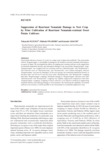Suppression of Root-Knot Nematode Damage to Next Crop by Prior Cultivation of Root-Knot Nematode-Resistant Sweet Potato Cultivars
| ISSN | 00213551 |
|---|---|
| NII recode ID (NCID) | AA0068709X |

Sweet potato (Ipomoea batatas (L.) Lam.) is a major crop in Japan and worldwide. The sweet potato cultivar ‘Koganesengan’ is susceptible to damage by the southern root-knot nematode Meloidogyne incognita in Japan. We investigated the effects of cropping new resistant cultivars on the suppression of nematode population density and subsequent damage to the succeeding ‘Koganesengan’ crops. ‘Koganesengan’ was cropped with two resistant cultivars (‘Daichinoyume’ and ‘Konamizuki’). The tuberous roots of ‘Daichinoyume’ and ‘Konamizuki’ were seldom damaged, whereas ‘Koganesengan’ was heavily damaged. In the next spring, the nematode population density in the plow layer soil (10–15 cm) was lower after ‘Daichinoyume’ and ‘Konamizuki’ cropping than after ‘Koganesengan’ cropping. Nematode damage to ‘Koganesengan’ tuberous roots after ‘Daichinoyume’ and ‘Konamizuki’ cropping was slightly suppressed compared to that after ‘Koganesengan’ cropping. Cropping of these cultivars is an effective method of suppressing nematode density and reducing damage to sweet potatoes. By clarifying the capability of resistant cultivars even overseas, it will be possible to use sweet potato as a nematode-suppressive crop.
| Date of issued | |
|---|---|
| Creator | Takayuki SUZUKI Hideaki IWAHORI Katsuki ADACHI |
| Subject |
cropping systems Ipomoea batatas Meloidogyne incognita resistance varieties |
| Publisher | Japan International Research Center for Agricultural Sciences |
| Received Date | 2019-04-04 |
| Accepted Date | 2019-10-02 |
| Available Online | |
| Volume | 54 |
| Issue | 3 |
| spage | 201 |
| epage | 209 |
| DOI | 10.6090/jarq.54.201 |
| Language | eng |
